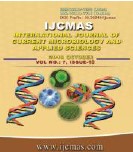


 National Academy of Agricultural Sciences (NAAS)
National Academy of Agricultural Sciences (NAAS)

|
PRINT ISSN : 2319-7692
Online ISSN : 2319-7706 Issues : 12 per year Publisher : Excellent Publishers Email : editorijcmas@gmail.com / submit@ijcmas.com Editor-in-chief: Dr.M.Prakash Index Copernicus ICV 2018: 95.39 NAAS RATING 2020: 5.38 |
Biotic and abiotic stresses are major constraints in the production of groundnut. Among biotic stresses apart from bacterial and viral diseases, many fungal diseases are of economic importance. The major fungal diseases are Early leaf spot (Cercospora arachidicola), Late leaf spot (Cercosporidium personatum), Rust (Puccinia arachidis), Botrytis blight (Botrytis cinera), Aflarot/Yellow mould (Aspergillus flavus), Damping off (Pythium spp.), Stem and pod rot (Ralstonia solani), collar rot (Aspergillus niger), Charcoal rot (Macrophom inaphaseolina), Anthracnose (Colletotrichum arachidis), Wilt (Fusarium oxysporum), Root rot (Fusarium solani), Stem rot (Sclerotium rolfsii), Damping off (Pythium spp.) and Leaf blight (Alternaria alternata). Among which Yellow mould, Collar rot, Wilt, Damping off and Leaf blight are seed borne which affect groundnut crop. For the management of different mycoflora, effect of nine bio-control agents Alternaria alternate, Aspergillus flavus, Aspergillus niger were observed in vitro condition. The biocontrol agents are Trichoderma viride, T. harzianum, T. koningii, T. hamatum T. virens, T. longibrachitum and T. lignorum along with two bacterial bio-agents P. fluorescens and B. subtilis evaluated in vitro were found antifungal to A. alternata. However, T. viride was found most effective with significantly least mycelial growth (5.33 mm) and its highest inhibition (94.07 %). The second and third best antagonists found were T. hamatum and T. koningii, with minimum mycelial growth of 13.33 mm and 17.12 mm and inhibition of 85.14 and 80.87 per cent, respectively.
 |
 |
 |
 |
 |